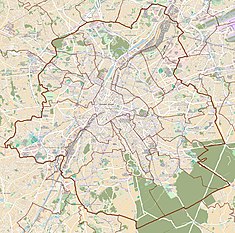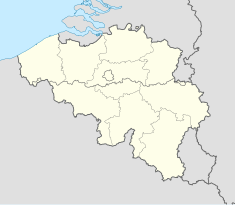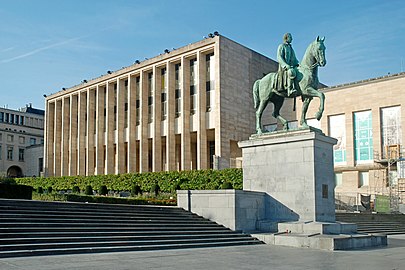Mont des Arts
 | |
| Location | City of Brussels, Brussels-Capital Region, Belgium |
| Coordinates | 50°50′38″N 04°21′24″E / 50.84389°N 4.35667°E |
| Built | 1954–1969 |
| Architect | Maurice Houyoux, Jules Ghobert René Péchère (garden) |
| Architectural style(s) | Modernism |
| Website | Official website |
The Mont des Arts (French, pronounced [mɔ̃dɛzaʁ]) or Kunstberg (Dutch, pronounced [ˈkʏnzdbɛr(ə)x] ⓘ), meaning "Hill/Mount of the Arts", is an urban complex and historic site in central Brussels, Belgium, including the Royal Library of Belgium (KBR), the National Archives of Belgium, the Square – Brussels Meeting Centre, and a public garden.
This site is located between the Rue Montagne de la Cour/Hofbergstraat and the Place Royale/Koningsplein in its "upper" part, and the Boulevard de l'Empereur/Keizerslaan and the Place de l'Albertine/Albertinaplein in its "lower" part. It is served by Brussels-Central railway station.
History
Early history
The area of the Mont des Arts knew different affectations during its history.

Between the 15th and the 18th centuries, the hill overlooking the neighbourhood was known as the Montagne de la Cour/Hofberg ("Hill/Mount of the Court") after the former
First Mont des Arts (1910–1954)
By the end of the 19th century, King Leopold II had the idea to convert the site into an arts' quarter and bought the whole neighbourhood. Various architects and urban planners were called upon to draw plans of the buildings, which were to accommodate all kinds of cultural institutions.[7] In the meantime, the City of Brussels' then-mayor, Charles Buls, had laid out a modest plan for the Saint-Roch district. His urbanistic and aesthetic conceptions were totally opposed to those of Leopold II. The burgomaster wanted to preserve as much as possible of the old district, whilst the king imagined grandiose projects for his capital. Very isolated, Buls was not followed by the municipal council, which voted for the king's project on 19 November 1894. Sickened, Buls resigned five years later.[8][6]
After the demolition of the old buildings in 1897–98, the site turned into an urban void because the project lacked sufficient finance. An agreement was finally signed in 1903 between the City of Brussels and the
-
Destruction of the Saint-Roch Quarter in 1897–98 to make space for the Mont des Arts/Kunstberg
-
The Mont des Arts in the 1920s showing Vacherot's temporary garden
Second Mont des Arts (1954–present)
Although the garden was conceived as temporary, it became a well-appreciated green area in the heart of the capital, but when the plans for the Mont des Arts came back by the end of the 1930s, it had to be demolished to create a new square as the centre of the urban renewal project. The project was entrusted jointly to the architects Maurice Houyoux and Jules Ghobert. Between 1956 and 1969, the park and its surroundings gave way to massive, severe geometric structures such as the Royal Library of Belgium (KBR) and the Congress Palace (now the Square – Brussels Meeting Centre). The new geometric garden, designed by the landscape architect René Pechère, was built upon the concrete slab covering the Albertine car park.[5] The construction of the Royal Library led to the complete disappearance of the old Palace of Orange-Nassau, with the exception of Saint George's Chapel. Faced with a wave of protests, it was decided in 1961–62 to integrate it into the library complex.[9] The inauguration took place in 1969.[6]
Present day
The Mont des Arts offers one of Brussels' finest views. Though the glass and steel cube forming the new entrance to the convention centre has modified the upper part of the complex, the perspective created by Péchère has largely been preserved. From the elevated vantage point, the famous tower of
Major tourist attractions are located within walking distance of the Mont des Arts: the Musical Instruments Museum (MIM), the Royal Museums of Fine Arts, the Royal Palace, and the Cathedral of St. Michael and St. Gudula.
-
The Royal Library of Belgium (KBR) and the Equestrian Statue of Albert I
-
The Mont des Arts carillon
-
The garden of the Mont des Arts during the day
-
The same view during nautical twilight
See also
- List of parks and gardens in Brussels
- North–South connection
- Brusselisation
- History of Brussels
- Culture of Belgium
- Belgium in the long nineteenth century
References
Citations
- ^ "Localisation de 'Escalier des Juifs' sur 14 plans de Bruxelles". www.reflexcity.net. Retrieved 29 October 2021.
- ^ "Localisation de 'Rue des Trois-Têtes' sur 14 plans de Bruxelles". www.reflexcity.net. Retrieved 29 October 2021.
- ^ "Place de la Justice". www.reflexcity.net. Retrieved 29 October 2021.
- ^ Anagnostopoulos & Houssiau 2006, p. 3.
- ^ a b c "Kunstberg - History". www.montdesarts.com. Retrieved 9 June 2018.
- ^ a b c d "Mont des Arts – Inventaire du patrimoine architectural". monument.heritage.brussels (in French). Retrieved 29 October 2021.
- ^ Liane Ranieri, Léopold II urbaniste, Brussels, Hayez (in French) (1973), p. 285
- ^ Demey 1990, p. 260.
- ^ Wasseige 1995, p. 26.
- ^ "Mont des Arts Gardens". visit.brussels. Retrieved 9 June 2018.
- ^ Poel, Nana Van De. "The History of the Mont des Arts in 1 Minute". Culture Trip. Retrieved 15 August 2018.
Bibliography
- Anagnostopoulos, Pierre; Houssiau, Jean (2006). The old palace of Coudenberg. Brussels, city of Art and History. Vol. 42. Brussels: Éditions de la Région de Bruxelles-Capitale. ISBN 978-2-93045-706-2.
- Demey, Thierry (1990). Bruxelles, chronique d’une capitale en chantier (in French). Vol. I: Du voûtement de la Senne à la jonction Nord-Midi. Brussels: Paul Legrain/CFC. OCLC 44643865.
- Demey, Thierry (2013). Bruxelles, des remparts aux boulevards (in French). Brussels: Badeaux. ISBN 978-2-930609-02-7.
- Wasseige, Manoëlle (1995). Le Quartier Royal. Bruxelles, ville d'Art et d'Histoire (in French). Vol. 15. Brussels: Éditions de la Région de Bruxelles-Capitale.
- Le Patrimoine monumental de la Belgique: Bruxelles (PDF) (in French). Vol. 1B: Pentagone E-M. Liège: Pierre Mardaga. 1993. p. 512–516.
External links
 Media related to Kunstberg/Mont des Arts at Wikimedia Commons
Media related to Kunstberg/Mont des Arts at Wikimedia Commons- The Mont des Arts at the Brussels Tourist Board website











